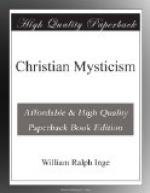[Footnote 158: E.g., he agrees with Iamblichus and Proclus (in opposition to Plotinus) that “the One” is exalted above “Goodness.”]
[Footnote 159: At the present time the more pious opinion among Romanists seems to be that the writings are genuine; but Schram admits that “there is a dispute” about their date, and some Roman Catholic writers frankly give them up.]
[Footnote 160: E.g., [Greek: katharsis, photismos, myesis, epopteia, theosis; hierotelestai] and [Greek: mystagogoi] (of the bishops), [Greek: photistikoi] (of the priests), [Greek: kathartikoi] (of the deacons).]
[Footnote 161: [Greek: hyperousios aoristia—hyper noun hynotes—henas henopoios hapases henados—hyperousios ousia kai nous anoetos kai logos arretos—alogia kai anoesia kai anonymia—auto de me on os pases ousias epekeina.]]
[Footnote 162: [Greek: oudemia e monas e trias exagei ten hyper panta krypsioteta tes hyper panta hyperousios hyperouses hypertheotetos.]]
[Footnote 163: [Greek: monas estai pases dyados arche] is stated by Dionysius as an axiom.]
[Footnote 164: See especially Bradley’s Appearance and Reality, some chapters of which show a certain sympathy with Oriental speculative Mysticism. The theory set forth in the text must not be confounded with true pantheism, to which every phenomenon is equally Divine as it stands. See below, at the end of this Lecture.]
[Footnote 165: See De Div. Nom. iv. 8; xi. 3.]
[Footnote 166: Dionysius distinguishes three movements of the human mind—the circular, wherein the soul returns in upon itself; the oblique, which includes all knowledge acquired by reasoning, research, etc.; and the direct, in which we rise to higher truths by using outward things as symbols. The last two he regards as inferior to the “circular” movement, which he also calls “simplification” [Greek: haplosis].]
[Footnote 167: The highest stage (he says) is to reach [Greek: ton hyperphoton gnophon kai di’ ablepsias kai agnosias idein kai gnonai].]
[Footnote 168: [Greek: tolmosa theoplasia] and [Greek: paidariodes phantasia] are phrases which he applies to Old Testament narratives.]
[Footnote 169: As a specimen of his language, we may quote [Greek: esti de ekstatikos ho theios eros, ouk eon eauton einai tous erastas, alla ton eromenon] (De Div. Nom. iv. 13).]
[Footnote 170: I am inclined to agree with Dr. Bigg (Bampton Lectures, Introduction, pp. viii, ix), that Dionysius and the later mystics are right in their interpretation of this passage. Bishop Lightfoot and some other good scholars take it to mean, “My earthly affections are crucified.” See the discussion in Lightfoot’s edition of Ignatius, and in Bigg’s Introduction. I am not aware how the vindicators of “Dionysius” explain the curious fact that he had read Ignatius!]




